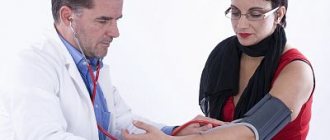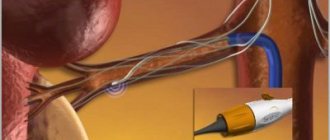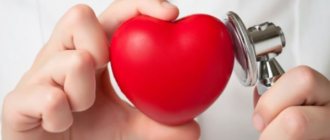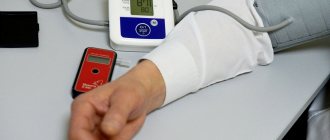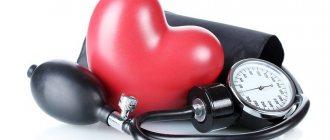Just a couple of decades ago, complaining about high blood pressure was the lot of older and elderly people. Today, arterial hypertension has become younger, like many diseases, due to the costs of today's lifestyle and level of workload. Increasingly, the diagnosis of hypertension is being made to young people 20-30 years old. The vast majority of cases of persistent increases in blood pressure are caused by one or another pathology of the cardiovascular system. In approximately 5-10%, the reason lies in the development of complications due to renal or endocrine diseases.
A blood pressure of 120/80 mmH is considered normal at a young age. Hg Art. or slightly lower (of course, individually determined deviations from the norm are possible). Blood pressure readings up to 140/90 are considered a prehypertensive state, 140/90 – 160/100 indicate stage 1 hypertension, and above 160/100 indicate stage 2 hypertension. In this case, we are not talking about infrequent episodic rises, for example, against the background of emotional stress.
The problem of hypertension at a young age has two negative aspects. First, in young patients, arterial hypertension may not produce significant symptoms for a long time; second, even in the presence of clearly defined signs of hypertension, a young person quite often ignores the need to visit a doctor and long-term constant treatment and the need to maintain a healthy lifestyle.
Childhood and adolescent hypertension
Arterial hypertension (hypertension) is a pathological condition of the body, which is characterized by a persistent increase in blood pressure. It is known that the risk of hypertension increases with age; in particular, it is recommended to pay special attention to blood pressure if a person is over 50 years old. And at a young age, few people measure blood pressure.
However, there is growing evidence that hypertension in adults has its preconditions in childhood. Problems with blood pressure levels in childhood become one of the risk factors as a person grows up.
But even in childhood and adolescence, arterial hypertension can be a symptom of early atherosclerosis and early development of cardiovascular diseases (CVD). Therefore, identifying children with this disease and successfully treating them may have important implications for the course of cardiovascular disease throughout the lifespan.
Risk factors for juvenile primary hypertension
Juvenile hypertension can be primary or secondary. Primary is one that is caused by various factors that impair the function of the systems that regulate blood pressure. Secondary hypertension is caused by other diseases of the body that provoke an increase in blood pressure (BP). So what can lead to the development of primary hypertension in children?
Obesity
The relationship between high blood pressure and weight begins in early childhood. The risk of high systolic blood pressure is usually more than twice as high in overweight children.
Floor
The prevalence of hypertension and prehypertension is higher in boys than in girls.
Family history
It is known that genetic factors account for approximately 30% of the variation in high blood pressure and up to 60-70% of hypertension in families.
Perinatal and neonatal factors
Every year, researchers study deeper the causes of hypertension. And now there is more evidence that they can occur as early as the perinatal (when the baby is in the womb) and neonatal periods (up to 28 days after birth).
Such reasons may be:
- the mother has preeclampsia (increased blood pressure that occurs during pregnancy);
- premature birth and low birth weight (body weight <2500 g, gestational age <36 weeks, or underweight for gestational age), associated with underdevelopment of the nephron (the structural unit of the kidneys) with a high risk of developing arterial hypertension;
- Absence or insufficient duration of breastfeeding is a risk factor for the further development of arterial hypertension.
It is worth noting that breastfeeding reduces the likelihood of blood pressure problems. Those who were breastfed during childhood had a blood pressure increase of 1.2 mmHg. Art. lower than in infants who were never breastfed. The reductions in both systolic and diastolic blood pressure were greater in exclusively breastfed infants, and the reduction in systolic blood pressure (SBP) became greater with duration of breastfeeding.
White coat hypertension
Imagine that just being in a medical office can affect your blood pressure readings. And there is a simple explanation for this: pressure can increase due to banal excitement.
“White coat hypertension” refers to the type that occurs when examined in a doctor’s office, but at home the blood pressure becomes normal. Among children who are diagnosed with high blood pressure in the doctor’s office, there are 2 groups:
- one with prehypertension;
- the other with normal blood pressure readings under normal conditions.
To identify hypertension in such cases, Holter ambulatory blood pressure monitoring is used (in other words, using a special automatic device, the blood pressure level is checked at home throughout the day at certain intervals).
Secondary arterial hypertension in adolescents
Secondary arterial hypertension in adolescents is, recall, the result of the influence of other diseases, sometimes hidden. If detected early, the progression of arterial hypertension (HTN) can be stopped.
Among these, the most common are kidney diseases and endocrine diseases, in particular diseases of the adrenal glands, including tumors, and diseases of the thyroid gland.
Problems can also be caused by vascular pathology, for example, coarctation of the aorta: congenital narrowing or complete closure of the lumen in a limited area of the aorta directly affects blood pressure levels.
The use of medications can also lead to problems with blood pressure. Among them:
- glucocorticoids (hormonal drugs used to treat a number of diseases, in particular rheumatoid arthritis, allergic diseases and others);
- cyclosporine and tacrolimus (immunosuppressive drugs, that is, those that weaken the immune response).
So, there are many risk factors that can trigger the development of hypertension at a young age. You also need to take into account that the normal level of pressure in adults and children differs. For example, pressure 120/80 mmHg. Art. under the age of 13 years is considered elevated. Therefore, it is better to do without self-diagnosis and consult a doctor.
The European Society of Hypertension (ESH - EUROPEAN SOCIETY OF HYPERTENSION) recommends checking blood pressure every two years for children who have not previously had problems with it, and annually for those who have already been diagnosed with hypertension, but without signs of damage to key organs. If these signs exist, your doctor will likely recommend monitoring your blood pressure more often.
Sometimes it’s better to play it safe than to regret later that you didn’t stop the progression of the disease in time.
Hypertension at a young age: questions and nuances
In modern society, there is a significant prevalence of arterial hypertension (AH), which affects 30-45% of the adult population. According to the World Health Organization, about 17 million people die each year due to cardiovascular diseases, of which complications of hypertension, such as heart attack and stroke, account for more than 9 million (55.3%).
Currently, arterial hypertension is becoming more common among young people. Early detection of hypertension through the use of the most modern diagnostic tests allows for timely treatment and prevention of complications.
Arterial hypertension is a persistent increase in blood pressure (BP) from 140/90 and above. Only a small part of elevated blood pressure (5-10%) is associated with secondary (symptomatic) hypertension, which occurs as a complication of other diseases (renal, endocrine). Basically, high blood pressure (90-95%) is a primary vascular disease, or hypertension.
Arterial hypertension, acting as an independent chronic disease, often becomes a cause of disability and disability. Moreover, in recent years there has been a “rejuvenation” of this pathology, i.e. Hypertension goes beyond the “disease of the elderly” and is increasingly found in young and middle age. The share of young able-bodied hypertensive patients (25-35 years old) accounts for 11.9%.
The development of hypertension in adolescence and young adulthood contributes to early damage to the most important organs (heart, kidneys, brain) and, as a consequence, a decrease in both the quality of life and its duration. Currently, effective measures have been developed for the prevention and treatment of patients with high blood pressure. The success of these interventions depends on the timely detection of hypertension, especially in young people.
There are a number of problems associated with diagnosing arterial hypertension in the young population:
- Low turnover of young patients, because In most cases, the disease is asymptomatic until organs are affected.
- Lack of dispensary (regular) monitoring of young people who are at high risk for developing hypertension. First of all, this is a burdened heredity (presence of high blood pressure among close relatives).
- Young people are often exposed to several risk factors for hypertension (chronic stress, smoking, excess body weight, abuse of table salt and alcohol, low physical activity).
Every sixth man under 44 years of age (at the peak of working activity) has high blood pressure and is at risk of developing complications of hypertension, such as heart attack, coronary heart disease, stroke and other diseases.
To identify the hereditary predisposition of young people to high blood pressure, a unique genetic test “Arterial Hypertension” has been developed and introduced into practice at the Center for High Blood Pressure.
This analysis allows you to calculate the individual risk of arterial hypertension and select medications that optimally and effectively reduce high blood pressure for a particular patient. To undergo this test, you simply need to donate blood from a vein. The analysis is taken once, its results are valid throughout a person’s life.
In addition, a patient with suspected hypertension is recommended to undergo the following tests:
- General blood and urine analysis; blood plasma glucose test (fasting); study of total cholesterol (TC), high-density lipoprotein cholesterol (HDL-C), low-density lipoprotein cholesterol (LDL-C), triglycerides (TG); study of potassium, sodium in blood serum.
- Determination of creatinine and protein in blood plasma, ultrasound of the kidneys.
- Ultrasound of the heart and ultrasound of the arteries of the neck to detect damage to other organs.
- Ambulatory BP monitoring, which provides information about the patient's real-life BP level, provides information about the BP level during the night; more accurately assesses the effectiveness of medications used to normalize blood pressure.
The choice of treatment tactics in patients with arterial hypertension is based on the degree of increase in blood pressure and individual risks of cardiovascular complications. All patients with hypertension and moderately high blood pressure (130-140/80-90), first of all, are recommended to change their lifestyle! Stop smoking, normalize your diet by reducing salt intake, and increase physical activity. You need to walk for 30 minutes 5 times a week.
Drug treatment for hypertension will be selected by a general practitioner. In difficult cases, patients with hypertension are treated by a cardiologist.
Thanks to a huge amount of research, the benefits of lowering blood pressure below 140/90 have been absolutely proven. This really prolongs life and protects a person from heart attacks and strokes. If you notice high blood pressure, do not delay seeing a doctor. Only a doctor can develop an individual program of examination, treatment and observation for you!
Arterial hypertension (hypertension) - symptoms and treatment
With regard to non-drug measures aimed at treating hypertension, the most convincing evidence has accumulated on the positive role of reducing salt intake, reducing and maintaining body weight at this level, regular physical training (exercise), no more than moderate alcohol consumption, as well as increasing the content of vegetables and fruits in the diet. Only all these measures are effective as part of long-term changes in the unhealthy lifestyle that led to the development of hypertension. For example, a decrease in body weight by 5 kg led to a decrease in blood pressure by an average of 4.4/3.6 mm Hg. Art. [9] - it seems like a little, but in combination with the other measures listed above to improve your lifestyle, the effect can be quite significant.
Improving lifestyle is justified for almost all patients with hypertension, but drug treatment is indicated, although not always, in most cases. If patients with increased blood pressure of 2 and 3 degrees, as well as with hypertension of any degree with a high calculated cardiovascular risk, drug treatment is mandatory (its long-term benefit has been demonstrated in many clinical studies), then with hypertension of 1 degree with a low and average calculated cardiovascular risk, the benefit of such treatment has not been convincingly proven in large clinical trials. In such situations, the possible benefit of drug therapy is assessed individually, taking into account the patient's preferences. If, despite improving lifestyle, the increase in blood pressure in such patients persists for a number of months during repeated visits to the doctor, it is necessary to re-evaluate the need for medication use. Moreover, the magnitude of the calculated risk often depends on the completeness of the patient’s examination and may turn out to be significantly higher than initially thought. In almost all cases of treatment of hypertension, they strive to achieve stabilization of blood pressure below 140/90 mmHg. Art. This does not mean that in 100% of measurements it will be below these values, but the less often the blood pressure, when measured under standard conditions (described in the “Diagnostics” section), exceeds this threshold, the better. Thanks to this treatment, the risk of cardiovascular complications is significantly reduced, and hypertensive crises, if they occur, are much less common than without treatment. Thanks to modern medications, those negative processes that, in hypertension, inevitably and latently destroy internal organs over time (primarily the heart, brain and kidneys), these processes are slowed down or suspended, and in some cases they can even be reversed.
Of the medications for the treatment of hypertension, the main ones are 5 classes of drugs [9]:
- diuretics (diuretics);
- calcium antagonists;
- angiotensin-converting enzyme inhibitors (names ending in -adj);
- angiotensin II receptor antagonists (names ending in -sartan);
- beta blockers.
Recently, the role of the first four classes of drugs in the treatment of hypertension has been especially emphasized. Beta blockers are also used, but mainly when their use is required by concomitant diseases - in these cases, beta blockers serve a dual purpose.
Nowadays, preference is given to combinations of drugs, since treatment with any one of them rarely leads to achieving the desired level of blood pressure. There are also fixed combinations of drugs that make treatment more convenient, since the patient takes only one tablet instead of two or even three. The selection of the necessary classes of medications for a particular patient, as well as their doses and frequency of administration, is carried out by the doctor, taking into account such data about the patient as blood pressure level, concomitant diseases, etc.
Thanks to the multifaceted positive effects of modern drugs, treatment of hypertension involves not only lowering blood pressure as such, but also protecting internal organs from the negative effects of those processes that accompany high blood pressure. In addition, since the main goal of treatment is to minimize the risk of its complications and increase life expectancy, it may be necessary to correct blood cholesterol levels, take medications that reduce the risk of blood clots (which leads to myocardial infarction or stroke), etc. Refusal Smoking, no matter how trivial it may sound, allows you to significantly reduce the risks of stroke and myocardial infarction associated with hypertension, and slow down the growth of atherosclerotic plaques in blood vessels. Thus, treating hypertension involves addressing the disease in many ways, and achieving normal blood pressure is only one of them.


